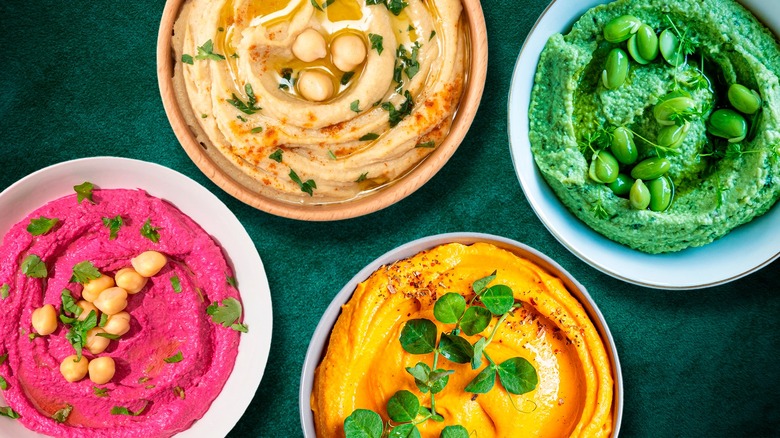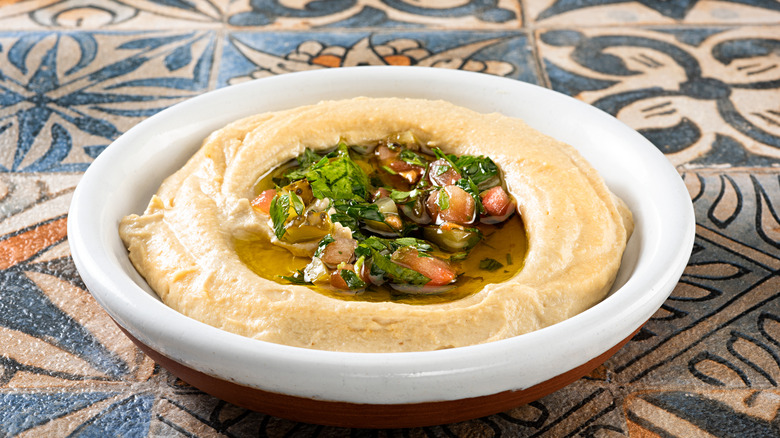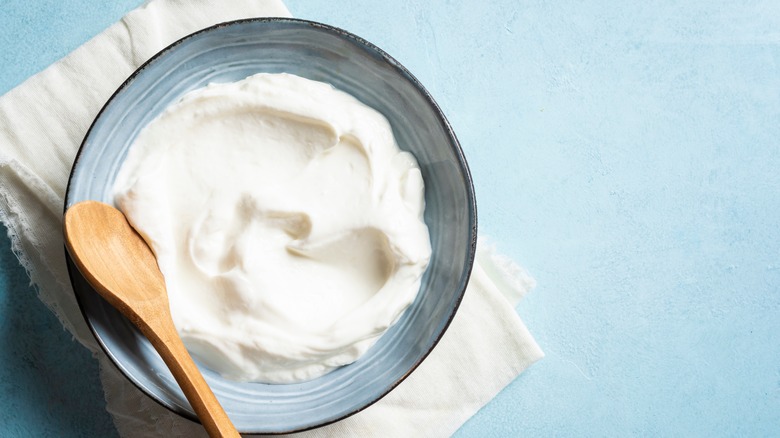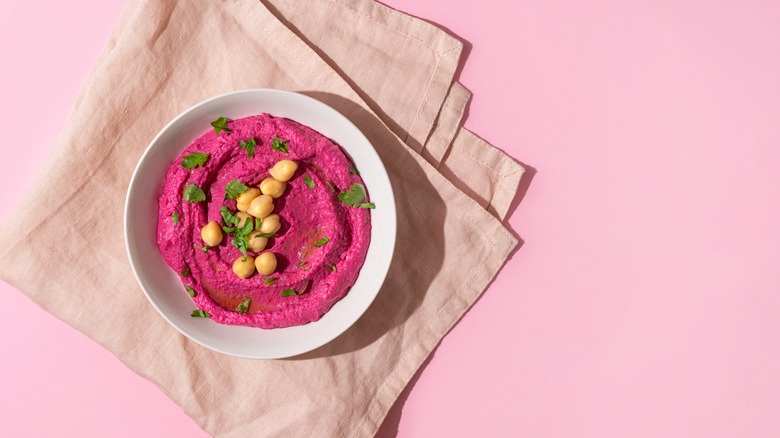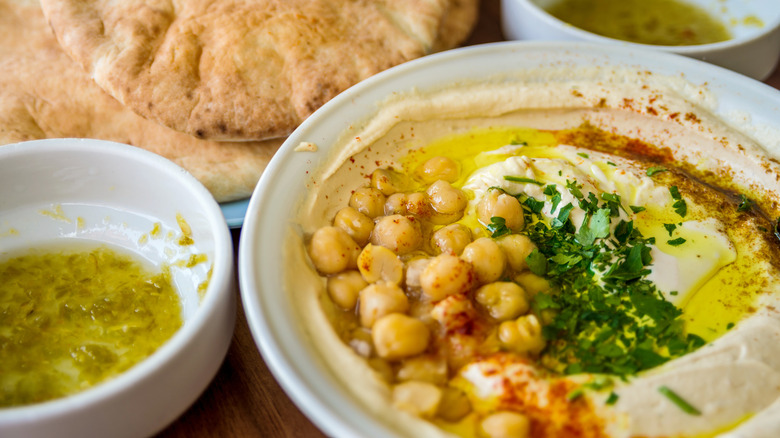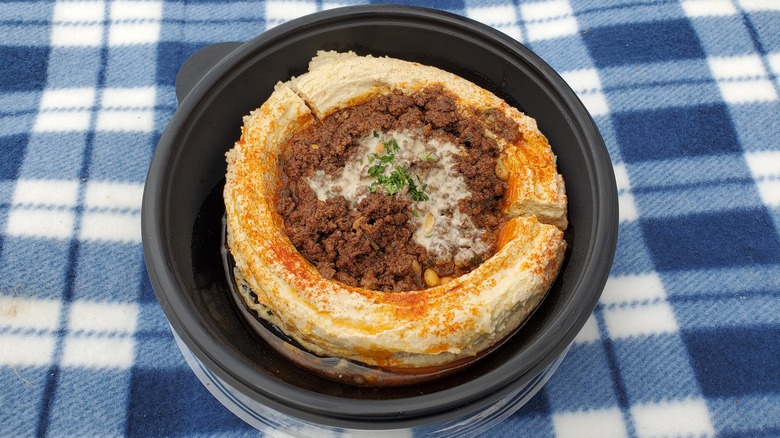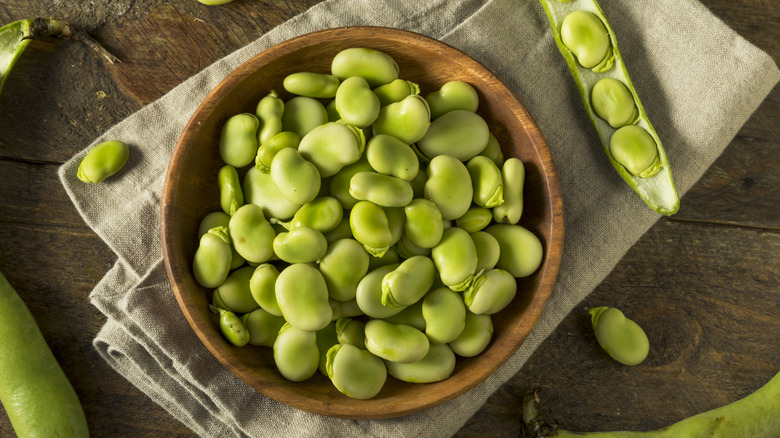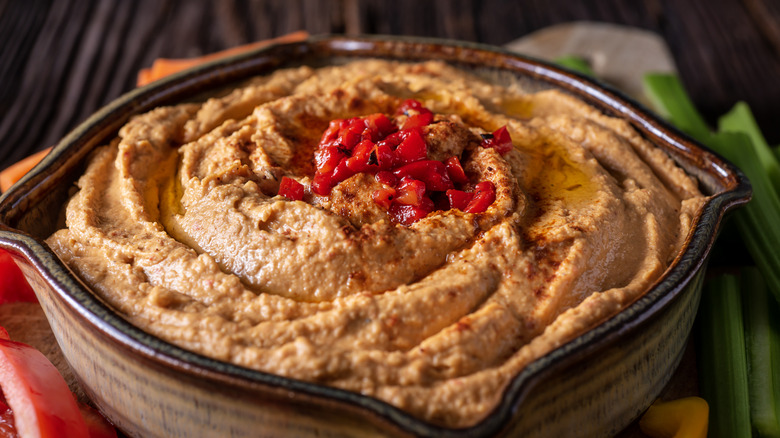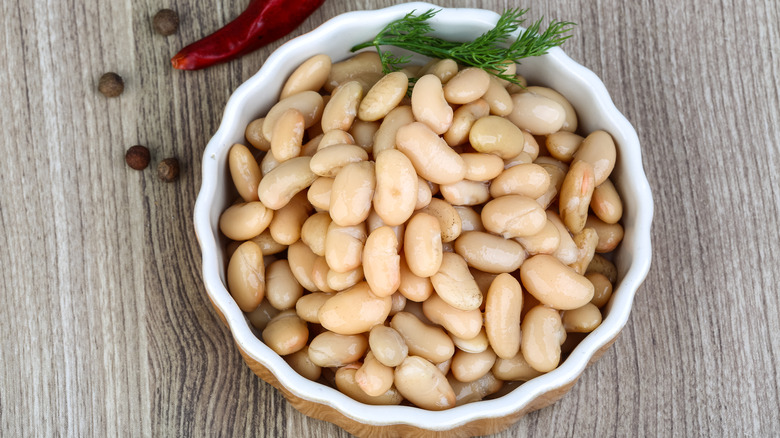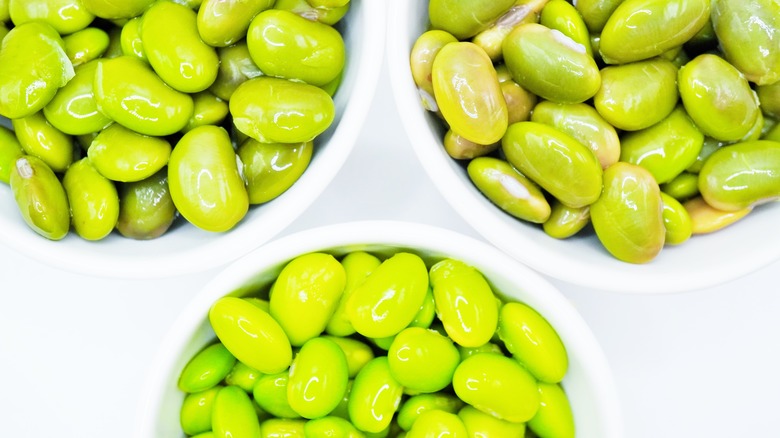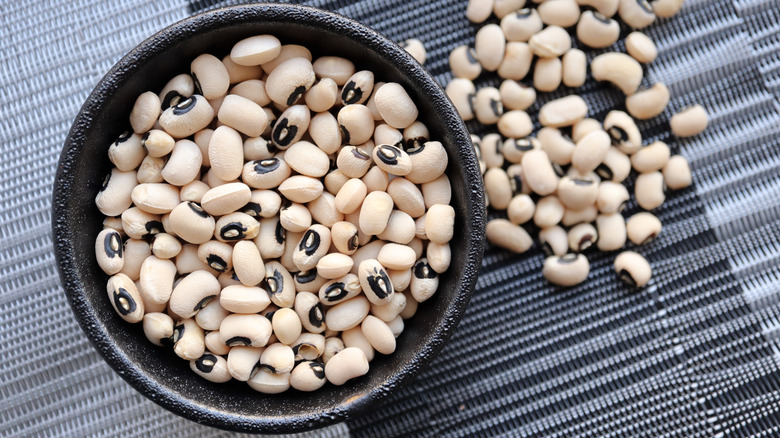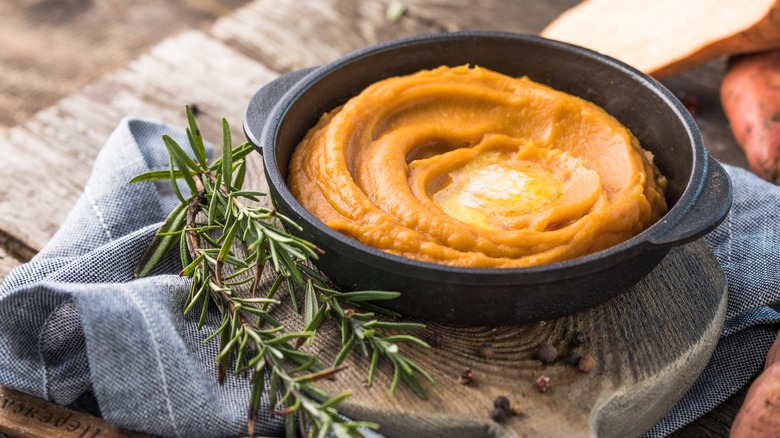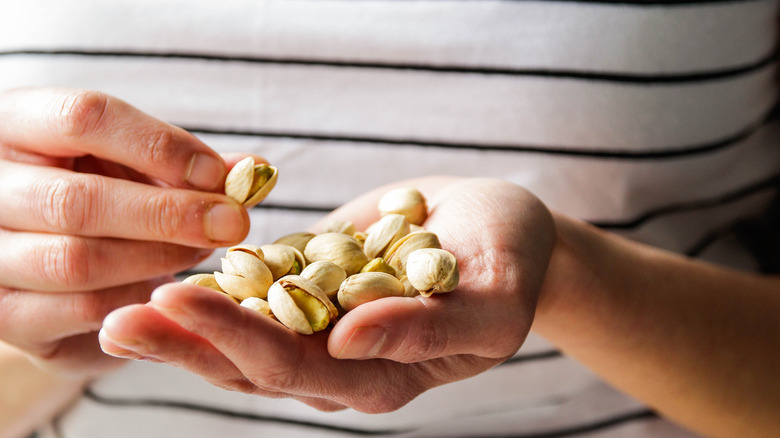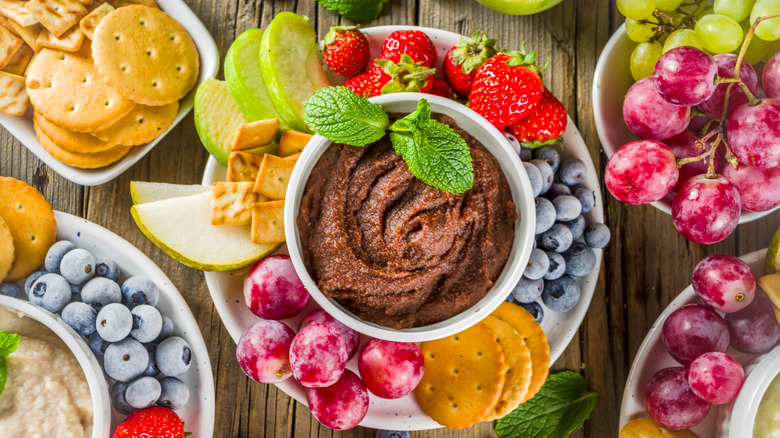13 Types Of Hummus, Explained
At its most basic, hummus — the Mediterranean spread (or dip, depending on how you see it) — is made with chickpeas, tahini, lemon juice, garlic, and olive oil. Given this simplicity of ingredients, it would be easy to imagine that six of one hummus equals half a dozen of the other. But this couldn't be more wrong.
First of all, a plethora of Mediterranean countries, including Turkey, Syria, and Israel, all claim to have invented the stuff — likely sometime in the 13th century — which can sometimes get quite political, as you can probably imagine. For instance, in 2008, Lebanese industrialists sued Israel for infringing food copyright laws by marketing hummus to the international community as an Israeli food. The effort failed, but the animosity seemingly remains.
Second, hummus comes in many different forms – partly because all those places probably did invent hummus — each with its own toppings, variations, and serving styles. Not only that, but hummus continues to receive facelifts, renovations, and upgrades even in places as far away from the Levant as the good old U.S. of A. — where chefs and amateurs alike incorporate some of the most unlikely ingredients, including sweet elements like chocolate or caramel apple. This may seem like blasphemy to some, but alas, the deed is done and cannot be ignored. So, let's take a deeper look at the types of hummus in circulation today, from the traditional styles to new adaptations.
Mediterranean hummus
Since we don't know exactly where hummus was first invented (and wouldn't dare pick a spot for fear of igniting, or exacerbating, the latest crisis), let us use a catch-all term to refer to hummus as its most primal, meaning with nothing more than chickpeas, tahini, lemon juice, garlic, and olive oil. This is how we most commonly know and love it in the U.S. This provides the basis for other variations seen throughout the Mediterranean and Middle East.
Typically, Mediterranean hummus will be served cold with pita bread and bite-sized vegetables, like baby carrots or broccoli florets, which are then dipped into the hummus. This makes a great appetizer to serve at a party or a nutritious mid-afternoon snack that is not too filling. While you can certainly find a hummus like this at your local grocery store, it is best to make it yourself by following this simple creamy hummus recipe. It's easy to make and only takes five minutes to prepare, as long as you're using canned chickpeas and not the dried variety, which would require a long soaking period. Serve it with your favorite vegetables, bread, or crackers, or spread over your sandwich bread with some cheddar cheese and sliced cucumber.
Hummus with yogurt
Another form of hummus you may have come across includes a helping of Greek yogurt, sometimes in the place of tahini, a sesame-based paste, and sometimes in addition to it. This version is commonly found in Greece, of course, but also in Turkey, which has a long history of sharing culinary traditions with its legendary nemesis from battles of Homeric fame.
In this version of the dish, the yogurt adds a tangy flavor to the hummus while also making it a bit lighter, especially if the tahini is omitted. Another benefit of using yogurt is that as you're preparing the hummus in your food processor, you can use this dairy product to help you adjust the consistency of the hummus to your liking, adding more yogurt if you need to thin it out.
To keep with the smoothness of yogurt, it may also be best to skin the chickpeas in this recipe. The skins tend to confer a lumpier texture to hummus, which is fine, but if you want your spread to be as smooth as yogurt, be sure to peel those pulses first. Meanwhile, bear in mind that the inclusion of yogurt will make your hummus spoil sooner than the regular version, especially if you're sensitive to extra tang.
Beet hummus
There is a whole collection out there of hummus with different toppings or flavorings, but only a few that completely integrate other ingredients into the hummus. One such recipe is this canned beet hummus, which can be conveniently made with fresh beets if you so choose. Once the beets are zapped in a food processor with the chickpeas and other basic hummus ingredients, the spread takes on an earthy flavor that adds depth to the typical hummus experience, with or without superficial toppings. It also gives the spread a bright pink color, making it the perfect snack for a themed birthday party or a Halloween event.
Meanwhile, you'll be incorporating a vegetable into your snack, which can never be a bad thing. According to Healthline, studies have shown that beets can lower your blood pressure and boost cardiorespiratory performance. Beets also have very few calories, especially when compared to chickpeas, so cutting your hummus with some beets might be the ideal way to create a lighter version of this popular snack.
Hummus masabacha
In the vast majority of cases, hummus will be prepared with chickpeas that have been mashed, blended, or blitzed in a food processor until smooth or slightly chunky. But there is a type of hummus that keeps those chickpeas intact, and that hummus is called masabacha. All the usual ingredients are present on the plate, but in this case, the chickpeas just float in the tahini sauce instead of blending in with it. The result is a similar taste to what you know, but a completely different texture.
And about that texture — there are better ways to achieve it than others. For instance, it is recommended that you use dried chickpeas instead of canned ones and that they be cooked until fully tender — undercooked chickpeas can be chalky and tasteless. You can also play around with that texture element and blend some of the chickpeas in with the tahini before mixing in the whole ones. Either way, this dish is best served in a bowl topped with plenty of parsley, za'atar, toasted pine nuts, and olive oil for color and flavor. You can also enjoy it with other typical hummus sides, like raw vegetables or toasted pita bread.
Meat-topped hummus
Serving hummus with a new topping every time doesn't change the fundamental nature of the dish. That said, there is a specific type of hummus that is typically topped with meat, served warm, and widely consumed primarily in Turkey, Lebanon, and Syria. Known locally as "hummus bil lahme," this translates from Arabic as "hummus with meat." This dish flies in the face of the idea that hummus is just a vegetarian substitute for something much more exciting. It shows that hummus is a hearty, flavorful spread that can stand up to other hearty ingredients, like spiced beef or sauteed lamb.
In this variant, the hummus is made with the usual ingredients but then served warm or cold with a topping of warm spiced minced beef that has been sauteed in onions and garlic, along with spices like cumin. And since you're cooking up practically a full meal here, you may as well go all out. Once you've scooped the meat onto the hummus, you can proceed to top it with roasted pine nuts, additional spices, and even some feta cheese.
Fava bean hummus
The word hummus literally means "chickpeas" in Arabic, so one would assume that pretty much any hummus recipe would include chickpeas, at least in part. Not so with fava bean hummus, which is still given that name despite the conspicuous absence of garbanzo beans. This version seems to be inspired by Egypt's propensity for using fava beans, even though the country claims to be the birthplace of chickpea hummus (but then all the eastern Mediterranean countries seem to claim that). Indeed, as Middle East historian Ari Ariel once told the BBC, "The earliest recipe I've seen for hummus that includes tahini is from an Egyptian cookbook." 13th-century cookbooks found in Cairo contained a recipe that called for pureed chickpeas, vinegar, pickled lemon, and spices.
While today's hummus recipes differ from that description, one can only assume it referred to something similar, if not exactly our modern-day hummus. Meanwhile, this fava bean hummus recipe seems to further alter the recipe we know by including cayenne pepper, ricotta, and spinach in the puree — and by serving it with pickled shallots, pistachios, and other unlikely candidates. The result is a colorful green spread dotted with interesting and tasty garnishes.
Roasted red pepper hummus
Roasted red pepper hummus is a popular variation on the hummus theme, but unlike what you might find in the refrigerator aisle at your local grocery store, the roasted red pepper is more than just a topping. Roasted red pepper adds a new depth of flavor to hummus, as it is blended into the chickpeas and other ingredients during the preparation process. Of course, you can also use roasted red peppers as a topping to drive home your point.
Another way to make this type of hummus is to simply incorporate muhammara into your usual hummus recipe. Muhammara is a Syrian dip or spread made with red peppers, walnuts, breadcrumbs, pomegranate molasses, and Middle Eastern spices like sumac and Aleppo chili flakes. Between the peppers and the molasses, it has a fairly sweet taste that blends nicely into the more acidic hummus. This muhammara recipe calls for the peppers to be broiled before being added to the food processor, which enhances the flavor with an added smokiness. You can also serve the two dips side-by-side with other Middle Eastern mezze as part of a dinner spread.
White bean hummus
Another type of hummus that doesn't necessarily contain chickpeas is white bean hummus, which is just as easy to make at home as the regular stuff. White beans encompass everything from cannellini to navy beans and more — basically any bean that is white and starchy inside. It is this starchiness, in fact, that helps provide such a smooth and creamy hummus. So if you're looking for an especially smooth hummus, the white bean may be the best way to go. Although removing the skins from chickpeas can help with the smoothness, it's a laborious prospect that is no longer necessary when white beans are already available — with or without the skin — to provide that smoothness.
White beans are also great options because they tend to have a mild flavor that is receptive to all manner of toppings or additions. With white beans, your roasted red peppers will stand out even more — both in flavor and color — while pomegranate seeds will give your spread a more decisive pop of tang and brightness. Either way, you can serve all of the usual trappings with white bean hummus, including warm pita bread or raw carrots.
Edamame hummus
This edamame hummus recipe might have led you to see that a pattern is emerging: Although traditional hummus is made with chickpeas, that doesn't mean you can't use any other legume you want to make a spread that is very similar in flavor and texture. Indeed, edamame hummus can be made by using any regular hummus recipe and simply substituting the chickpeas for this little green legume, which is an immature soybean. The result may be greener than what you're used to, and with a softer flavor, but the tahini, lemon, garlic, and olive oil will ensure the overall effect remains similar in taste and application.
Edamame can also be a nice change of tune if you're looking for certain health benefits. According to Healthline, this legume may lower cholesterol and promote a healthy regulation of blood sugar, in part because it measures low on the glycemic index. Just make sure you shell edamame before tossing it in the food processor with the rest of the ingredients. You can also buy it already shelled at the grocery store.
Black-eyed pea hummus
Sometimes chefs play around with traditional recipes to give them their own spin and sometimes they do it to change things up a bit. But most of the time, it seems, they do it because they have a dearth of a certain ingredient or an abundance of another. In the case of black-eyed pea hummus, which puts a Southern United States bent on the classic Middle Eastern snack, the latter reason seems to be the cause of the switch. Black-eyed peas have been a beloved Southern comfort food for centuries and they are seen as powerful good-luck charms, especially when eaten on New Year's Eve and within African American communities.
If you, too, want luck on your side, combine cooked black-eyed peas in a food processor with roasted garlic, lemon juice, olive oil, tahini, onion powder, and your choice of spices, and you'll have an excellent nutritious dip to partake in at New Year's or during any other time of the year. Serve the dip with the usual hummus trappings, your favorite crackers, or pretzels.
Sweet potato hummus
Sweet potatoes are inherently creamy, which makes them an ideal choice to add to a creamy spread like hummus. The fact that they also have a subtle sweetness that goes well with savory applications also doesn't hurt. This sweet potato hummus with smoked paprika recipe stands as an excellent example of how to combine chickpeas with root vegetables.
To make it, zap bright orange roasted sweet potatoes in a food processor with chickpeas, garlic, tahini, lemon juice, cumin, and smoked paprika — whose smokiness makes a great complement to sweet potatoes in all manner of recipes. Don't be shy about using it: The spice in smoked paprika is mild, so feel free to blend it into the mixture and sift some on top after it's done. Given the silky texture of the potatoes, it's best to remove the skin of the chickpeas before making this recipe. That skin can lead to a lot of lumpiness, which would undermine the smooth texture of the potatoes.
Pistachio and lentil hummus
Lentils might not be the first legumes that come to mind when you think of hummus. Aside from the fact that hummus is usually made with chickpeas, lentils often have a drab green appearance that can be decidedly unappetizing. They might not be at the top of your list when you think about fresh dips to pop into your mouth with crackers or crudites. Yet this pistachio and lentil hummus is just as fresh as any other, thanks to the presence of the usual lemon juice as well as a generous helping of parsley.
Prepare this recipe by focusing first on the pistachios: You don't want to find large chunks of them buried in your hummus, ready to take out your tooth, so it's best to first pulse them in a food processor until they take on a powdery consistency. This will allow the nuts to turn into a paste once the lemon juice, water, olive oil, garlic, and spices are added. Lastly, the addition of the parsley imparts a brighter taste while also turning the green of this spread into something a little less drab.
Dessert hummus
Hummus for dessert? It's probably not most people's first choice, but if you're a die-hard hummus lover, it might be just the thing for you. Or, conversely, you might think it signals the beginning of the end. Either way, it's a thing now, so it's earned a spot on this list of hummus types. After all, we're only here to explain them, not necessarily extol them.
The truth is that there is now such a thing as chocolate, maple, caramel apple, and even cookie dough hummus, all made with a base of pureed chickpeas. The first known introduction of this food occurred at a fair at the University of New Hampshire in 2009, where the peanut butter hummus became especially popular. But it wasn't until 2017 that a "Shark Tank" idea for sweet hummus became a bona fide dessert hummus-producing company known as Delighted By.
Whatever the details of dessert hummus' origin story, we know that it was born and developed in America, which is why many Middle Easterners see this variation as cultural appropriation. Indeed, as Dafna Hirsch, a professor at the Open University of Israel told Eater, making sweet hummus "is not respecting the tradition of other people."
Static Media owns and operates Tasting Table and Food Republic.
